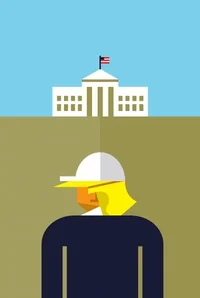By T. Christian Miller for ProPublica
 President Donald Trump built his campaign on the promise of a wall across the U.S.-Mexico border. Just a month after his inauguration, the Department of Homeland Security announced plans to begin construction.
President Donald Trump built his campaign on the promise of a wall across the U.S.-Mexico border. Just a month after his inauguration, the Department of Homeland Security announced plans to begin construction.And last Friday, the department took a step to make sure it will look good.
In a little-noticed update, the department now says it wants a wall that will be "nominally 30 feet tall," and, importantly, that bids will be judged on "aesthetics," as well.
The new language, perhaps coincidental but likely not, appears to be a bureaucratic translation of Trump's oft-repeated promise to build a "beautiful" wall from 30 to 55 feet high.
Of course, the federal government does not typically focus on beauty in building its walls, fences and barriers. Procurement officers prefer to evaluate bids on concrete things such as price or a company's past performance — or, for that matter, concrete itself. As a contract requirement, appearances usually only figure into high-end projects (think of the Vietnam Veterans Memorial).
But the Trump administration's apparent demand for a wall with style is only one of the oddities that has arisen in planning for the massive project, estimated to cost as much as $21.6 billion and cross hundreds of miles.
 |
| For more cartoons by Wiley Miller, CLICK HERE. |
The rush for raising the wall has veteran contracting officers comparing the process to the rebuilding of Iraq and Afghanistan, multibillion-dollar efforts widely considered failures because of poor planning.
"This isn't normal," said Steven L. Schooner, a professor of government contracting at George Washington University. "This is shoot first, aim later."
A CBP spokesman said the agency was "not in a position" to conduct an interview for this story.
The initial request, released with fanfare on Feb. 24, was not for building the actual wall, but for a prototype of a "total wall solution."
The real bidding specifications — where the government would lay out details about the size, shape and construction of the wall — have yet to be announced. It's not clear when they will be.
In another bidding document posted last week, the department's "Procurement Innovation Lab" acknowledged that erecting the wall was going to be complex business.
Lab officials asked for help from industry to map out a comprehensive plan. America's current 2,000-mile long border with Mexico is defended by a patchwork of physical and natural barriers, supplemented by the presence of U.S. Customs and Border Patrol agents.
"This strategy will need to accommodate the entire Southwest Border, which has a quite diverse range of terrain, foliage, population, wildlife, and other features," explained the notice, known formally as a request for information.
The document raised an unusual question: How should the government pay for the wall?
The answer is usually straightforward. Under the U.S. Constitution, Congress appropriates funding for government projects.
In this case, however, Trump has vowed to make Mexico foot the bill, a proposition the Mexican government has vigorously rejected. Trump has responded by seeking cost savings. The Washington Post reported Tuesday that White House officials have suggested raiding the budgets of the Coast Guard, the Transportation Security Agency and the Federal Emergency Management Agency to find money for the wall.
Perhaps reflecting the uncertainty, Customs officials asked interested parties for their own ideas, in the form of five-page white papers with "models for financing, constructing and maintaining the wall."
Another question: Will building the wall require "major deviations from federal law or regulation"?
More than 500 companies have expressed interest in the project. They include the usual cast of giant construction firms involved in federal projects, such as Tutor Perini Corp, Fluor Corp, and KBR, Inc., a former subsidiary of Halliburton once known as Kellogg, Brown & Root.
But the list also includes more than a hundred smaller minority and veteran-owned firms, who receive special consideration under government contracting laws. Eleven percent of the companies are owned by Latinos.
Also among the interested parties: private security contractors, whose presence will almost certainly be necessary to protect the companies building the wall from protesters, vandals and thieves.
In war zones and New Orleans after Hurricane Katrina, such companies raised troubling questions about the use of force against civilians, including the murder of Iraqi and Afghan citizens. They also raised the price of some projects by as much as 25 percent.
ProPublica is a Pulitzer Prize-winning investigative newsroom. Sign up for their newsletter.